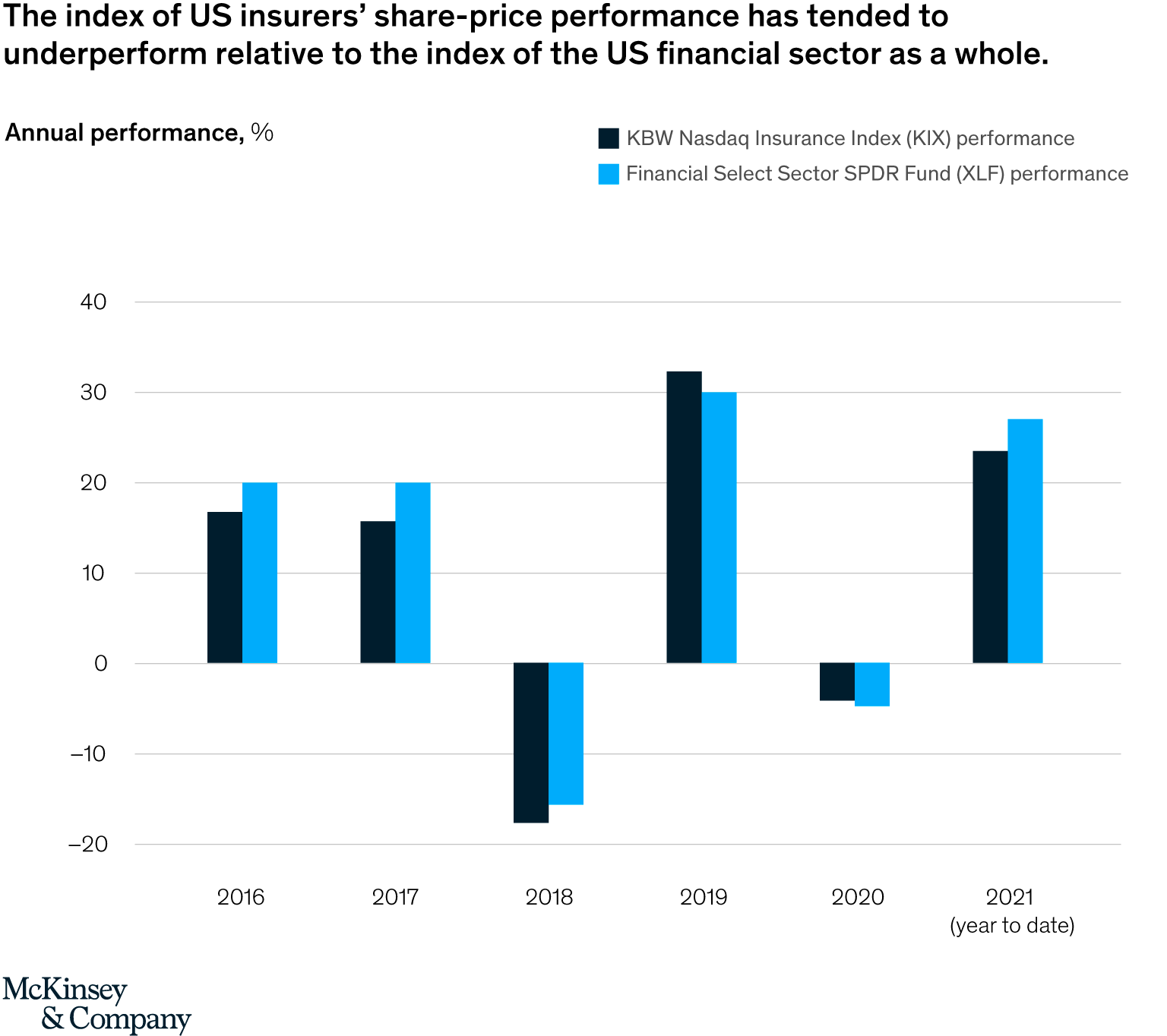Insurers often don’t get the credit they deserve from investors. Although a core group of insurers has delivered strong operational results, the sector’s share-price performance has lagged that of other financial companies. Consider that the performance of the KBW Nasdaq Insurance Index (KIX), which reflects the performance of US insurance companies, has not surpassed that of the Financial Select Sector SPDR Fund (XLF), which tracks the performance of all US financial-services companies, in four of the past five years, even though many insurers have long track records of generating attractive operating results (exhibit).

We attribute a significant part of this discrepancy to the lack of a compelling narrative that helps investors fully recognize the intrinsic value of insurance businesses. To close that gap, insurance leaders—C-suite executives and investor-relations professionals—should identify and clearly articulate why investors should be drawn to their companies. This means leaders need to effectively communicate their long-term strategies and performance targets and link them to underlying business drivers. At the same time, insurers should refresh their investor communications materials—regularly—and use annual investor days to supplement existing channels for investor interactions (if they are not already doing so). Our analysis found that only a quarter of the 25 largest North American property and casualty (P&C) and life insurance carriers (by market capitalization) hosted an investor day in the past year; half of them held an investor day in the past three years. Finally, insurers should address investor concerns promptly and directly rather than allow them to linger.
Investor misgivings: Complex, risky businesses
Investing giants such as Warren Buffett have long recognized the attractive economics of a well-run insurer that can invest premiums before claims emerge. Unfortunately, some institutional equity investors tend to sidestep the industry because of its complexity.
In our experience, institutional investors are wary of insurers’ sensitivity to low interest rates, their regulatory and accounting complexity, and the risks inherent in long-tail products such as annuities, long-term care insurance, and decades-old commercial P&C liabilities. As a result, many investors avoid the industry or minimize the amount they allocate to insurance equities.
The most successful narratives designed for insurance-carrier investors tend to come from companies that provide capital-light products. These capital-light offerings, such as small commercial P&C products or voluntary employee benefits, typically generate strong top-line growth, higher-than-average underwriting margins, and ROE greater than the cost of capital, with few legacy concerns.
Attracting investors: Simplify narratives, educate audiences
Insurers should use the power of an effective narrative to help align their market value with their intrinsic value—not to boost company stock price by creating short-term enthusiasm. The key is to tell a clear story that distills complex concepts and inspires investors to invest in companies with the markers of favorable long-term performance. This foundation can help carriers get full credit from investors for their achievements, such as transformations and expansions into new businesses. While insurers cannot eliminate complexity from their businesses, they should educate investors on how to holistically assess them. This can help keep investors from fixating on unknown risks, which affect every sector.
Insurers should take five steps to sharpen their investor narratives:
- Educate investors about why they should be interested in the company. Carriers should target equity investors focused on intrinsic value by highlighting their unique sources of competitive advantage. If possible, they should emphasize their sustainable top- and bottom-line growth, favorable risk-adjusted ROE compared to the cost of equity, and increasing margins. If investors can better understand these performance factors, they may become more comfortable with the dynamics—including the risks and nuances—of the insurance business.
- Communicate long-term targets and explain how they interact with the business’s underlying drivers. These discussions are central to value creation, particularly long-term growth in earnings and book value per share, which are indicators of increasing enterprise value. To maintain a long-term focus, insurers should focus on long-term guidance and avoid quarterly—and even annual—earnings guidance; short-term earnings guidance can attract unwanted attention from investors who might be less focused on long-term value creation.
- Use strategic pivots as opportunities to engage investors. Many insurers are undertaking transformations to improve their top-line and earnings profiles, while others are using M&A—both acquisitions and divestitures—to enhance growth and ROE.2 Insurers should highlight these developments in telling their stories to investors to ensure that their company valuation reflects sustainable strategic and operational improvements.
- Update investor communications and hold annual investor days. To attract new generalist investors who may not be as familiar with the insurance industry, investor communications should use plain, accessible language to convey their companies’ stories, underlying trends, and key performance indicators. Insurers that do not currently hold annual investor days should consider adding them to their regularly scheduled events to complement their investor conference schedules; investor days allow insurers to tell a more in-depth version of their stories and showcase their management teams.
- Directly address investors’ concerns. Insurers should identify areas of investor concern, objectively determine whether they are justified, and address them as needed. For example, life insurers could provide evidence of how their businesses might be less sensitive to interest rates than the marketplace perceives them to be. Similarly, P&C insurers could provide proof of effective risk-management practices in response to increasingly severe catastrophic events.
Insurers need to generate strong fundamental performance, but an effective investor narrative can be just as important for companies’ long-term share-price performance. The time for insurers to remedy investor misconceptions about their businesses is now.
Alex D’Amico is a senior partner in McKinsey’s New York office, where Jay Gelb is a partner and Zane Williams is a senior expert; Grier Tumas Dienstag is an associate partner in the Boston office.
Download the article here.



